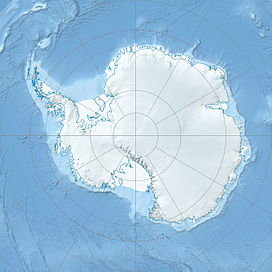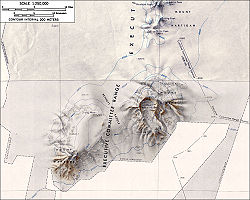- Mount Sidley
-
Mount Sidley 
Aerial view of the Mt. Sidley caldera from the southwestElevation 4,285 m (14,058 ft) [1][2] Prominence 2,517 m (8,258 ft) [1] Listing Volcanic Seven Summits, Ultra Location Marie Byrd Land, Antarctica Range Executive Committee Range Coordinates 77°02′S 126°06′W / 77.033°S 126.1°WCoordinates: 77°02′S 126°06′W / 77.033°S 126.1°W Geology Type Shield volcano (extinct) Mount Sidley is the highest volcano in Antarctica, a member of the Volcanic Seven Summits, with a summit elevation of 4,181–4,285 metres (13,717–14,058 ft).[1][2] It is a massive, mainly snow-covered shield volcano which is the highest and most imposing of the five extinct volcanic mountains that comprise the Executive Committee Range of Marie Byrd Land. The feature is marked by a spectacular 5 km wide caldera[3] on the southern side and stands NE of Mount Waesche in the southern part of the range.
The mountain was discovered by Rear Admiral Richard E. Byrd on an airplane flight, November 18, 1934, and named by him for Mabelle E. Sidley, the daughter of William Horlick who was a contributor to the 1933–35 Byrd Antarctic Expedition. Despite its lofty status, the volcano languishes in obscurity due to its extremely remote location. It is little known even in the mountaineering world compared to the far more famous Mount Erebus, the second highest Antarctic volcano which is located near the U.S. and New Zealand bases on Ross Island. The first recorded ascent of Mount Sidley was by New Zealander Bill Atkinson on January 11, 1990, whilst working in support of a USAP scientific field party.
See also
References
- LeMasurier, W. E.; Thomson, J. W. (eds.) (1990). Volcanoes of the Antarctic Plate and Southern Oceans. American Geophysical Union. pp. 203–207. ISBN 0-87590-172-7.
- "Amar Andalkar's Ski Mountaineering and Climbing Site. Skiing the Pacific Ring of Fire and Beyond". 1997–2007. http://www.skimountaineer.com/ROF/RingOfFire.html. Retrieved 2005-01-14.
- ^ a b c Antarctica on peaklist.org
- ^ a b . The map above showed the elevation as 4,181 m (13,717 ft).
- ^ Kurt S. Panter, Philip R. Kyle and John L. Smellie (1997). Petrogenesis of a Phonolite-Trachyte Succession at Mount Sidley, Marie Byrd Land, Antarctica, Journal of Petrology 38(9), 1225-1253.
Volcanic Seven Summits South America: Ojos del Salado • Africa: Kilimanjaro • Asia: Damavand • Europe: Elbrus • North America: Pico de Orizaba • Australia (Oceania): Giluwe • Antarctica: Sidley
Categories:- Volcanic Seven Summits
- Shield volcanoes
- Volcanic calderas
- Volcanoes of Antarctica
- Extinct volcanoes
- Mountains of Marie Byrd Land
Wikimedia Foundation. 2010.


